James G. Frazer:
|
by Stefan Stenudd |
James George Frazer (1854-1941) was born in Glasgow, getting his education in the Classics there and at Cambridge. Soon, he concentrated on anthropology, giving lectures at several English universities through his life.
His major work on comparative religion and mythology, The Golden Bough, was originally published in 1890, as a two volumes work, in the following decades to expand considerably until reaching the twelve volumes of the third edition, published 1906-1915. However, it was his shortened single volume version of 1922 that reached the widest audience, also way outside the academic world.
Although The Golden Bough is full of myths and even more so of mythological fragments, its main focus is on cult, ritual, and superstition. Frazer researched the emergence of religion and its reasons, thinking primarily of what he called the religion of the Aryans:
The popular superstitions and customs of the peasantry are by far the fullest and most trustworthy evidence we possess as to the primitive religion of the Aryans. [James G. Frazer, The Golden Bough: A Study in Comparative Religion, vol. 1, London 1890, viii.]
"Savages"
Like many of the 19th century and early 20th century writers on this as well as other social science subjects, Frazer has a disturbing view on primitivity as a label for cultures prior to or different from his own. Although it can be somewhat excused by the context in which they worked, it makes their theories lose just about all their credibility.Also in his 1922 abridged version of The Golden Bough, Frazer insists on a low appreciation of "primitive" — even the magician, who would have been some kind of elite in that ancient society: "he never analyses the mental processes on which his practice is based, never reflects on the abstract principles involved in his actions." [James G. Frazer, The Golden Bough: A study of magic and religion, abridged edition, New York 1922, 11.]
That would make him a lousy magician, not to mention the burning question: how would Frazer know? Still, he boldly continues in the same paragraph: "the very idea of science is lacking in his undeveloped mind."
It is even more bluntly presented in a book of his from 1933, a revealing year in this context, where he declares:
Existing savages are doubtless highly developed physically, intellectually and morally, by comparison with their ancestors in the remote past, but by comparison with the civilized nations of the present time they may fairly be described as primitive in a relative sense. [James G. Frazer, The fear of the dead in primitive religion, London 1933, 4f.]
Regarding primitive religion, he clarifies on the same page that he means "the religion of the backward or uncivilized races; in other words, savages and barbarians".
Frazer speaks of primitive man and the savage, the latter term also applied to contemporary hunter and gatherer societies, making them the opposite of civilized man, by which he means his fellow western population having adapted the world view presented by natural science.
He takes a lot for granted about the lack of intellectual capacities in those not "civilized." He regards them as completely unable to recognize the flaws in their beliefs, and does not at all allow them doubts in their own traditions and mythologies, nor the ability to think of them in any kind of symbolic way: "the savage, whether European or otherwise, fails to recognize those limitation to his power over nature which seems so obvious to us." [Frazer 1890, vol. 1, 30.]
Frazer insists that to them every superstition is just the way things are. But that is not proven by the vast volume of myths and rites he goes through. If it were, the customs of the monotheistic societies would not rank any higher. He just bases his assumptions on prejudice and a questionable application of the principle of evolution.
His basic theory is that "primitive man" was trying magic, first and foremost in fertility cults, as a means to control aspects of life that were beyond hands-on control, and that this magic evolved into religion, which in turn much later evolved into science. Thereby, he defined magic as a kind of pseudo-science. When it failed to provide sufficient results, people had to accept the power of fate and magic was replaced by prayers and sacrifice. [Frazer 1890, vol. 1, 31.]
The last stage of this development, according to Frazer, is into scientific thinking, albeit by a detour through the mechanical thinking implicit in the practice of magic:
But when, still later, the conception of the elemental forces as personal agents is giving way to the recognition of natural law; then magic, based as it implicitly is on the idea of a necessary and invariable sequence of cause and effect, independent on personal will, reappears from the obscurity and discredit into which it had fallen, and by investigating the causal sequences in nature, directly prepares the way for science. Alchemy leads up to chemistry. [Frazer 1890, vol. 1, 32.]
Fear of the Dead
Yet, regarding the very origin of religions beliefs, Frazer later developed a firm belief that it depended on the fear of the dead. He states it very clearly in the preface to the abridged edition of The Golden Bough published in 1922:But I am so far from regarding the reverence for trees as of supreme importance for the evolution of religion that I consider it to have been altogether subordinate to other factors, and in particular to the fear of the human dead, which, on the whole, I believe to have been probably the most powerful force in the making of primitive religion. [Frazer 1922, vii.]
Later, he wrote a book on this very subject, The Fear of the Dead in Primitive Religion, where he repeated his credo: "there can be little doubt that the fear of the dead has been a prime source of primtive religion." [Frazer 1933, v.] This book is his last major work.
It should be noted that he is not talking about the fear of death, but living people's fear of those who have died. It would be so much easier to follow his chain of thought if he were to describe the significance of the fear of death — not the dead — in the cults, rituals, and mythologies of religions.
Why Had the Priest to Slay His Predecessor?
The original edition of The Golden Bough, though, is all about the emergence and evolution of human efforts to control the world with the means of magic, worship, and ritual.Frazer begins quite poetically with a painting by J. M. W. Turner of a scene from the Aeneid, where Aeneas and the Sybil have just presented the golden bough to the gatekeeper, allowing them entry to the Elysian Fields. Frazer describes the scene as "suffused with the golden glow of imagination in which the divine mind of Turner steeped and transfigured even the fairest natural landscape." [Frazer 1890, vol. 1, 1.]
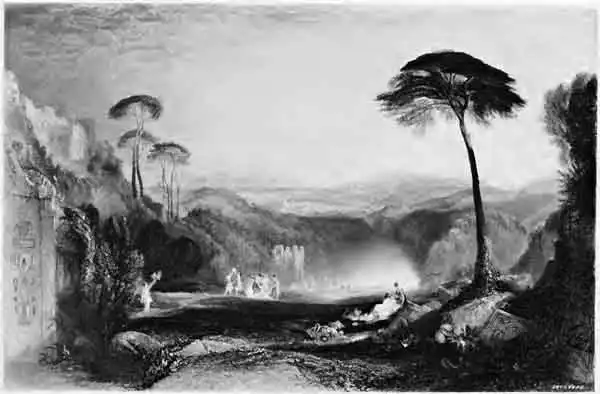
The Golden Bough by J. M. W. Turner, 1834. From Frazer's book, 1890.
This leads him to an antique tradition in the sanctuary called Diana of the Wood of having the succession of its priesthood done by slaying the previous priest in combat. Those who did so earned the title King of the Wood.
But this challenge was only allowed a runaway slave who had first broken of a bough from a certain tree in the sanctuary. That bough was said to be the same as the golden bough Aeneas needed to enter the world of the dead. This unique and gruesome tradition intrigues Frazer and triggers him to write:
The questions to be answered are two: first, why had the priest to slay his predecessor? and second, why, before he slew him, had he to pluck the Golden Bough? The rest of this book will be an attempt to answer these questions. [Frazer 1890, vol. 1, 6.]
That takes him an impressive 816 pages in two volumes to figure out.
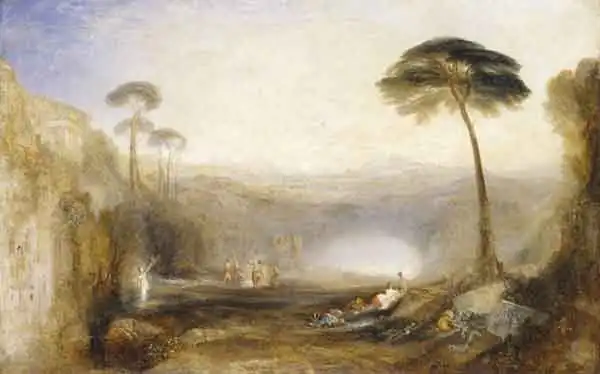
The Golden Bough by J. M. W. Turner, 1834. The original oil painting.
By his voyage through countless superstitions, myths, and rituals, Frazer concludes [James G. Frazer, The Golden Bough: A Study in Comparative Religion, vol. 2, London 1890, 359ff.] that the golden bough is the mistletoe and all the beliefs connected to it. Its gold is the fiery golden shine of the sun, as a sign of its potency.
Furthermore, the tree from which it is plucked is an oak, by Frazer regarded as the most sacred of trees in many traditions. The mistletoe is the vessel of life of its bearer, in a magic belief that only through this vessel can life be taken away. The King of the Wood at the Diana sanctuary represents the tree from which the golden bough has to be plucked, or he can't be killed properly.
Frazer connects it all to the winter and summer solstices, ritually celebrated in many parts of the world, in the past as well as presently. So, it is all about the rejuvenation of the seasons: "The King of the Wood lived and died as an incarnation of the supreme Aryan god, whose life was in the mistletoe or Golden Bough." [Frazer 1890, vol. 2, 370.] He ends his text with the French expression, familiar to just about all monarchies: "Le roi est mort, vive le roi!" [ Frazer 1890, vol. 2, 371.]
It would not take a lot of imagination to link this deified king, killed and resurrected in connection to a tree and a bough, to the crucified Christ. That is even more evident from the significance Frazer gives it:
For we must not forget that the king is slain in his character of a god, his death and resurrection, as the only means of perpetuating the divine life unimpaired, being deemed necessary for the salvation of his people and the world. [Frazer 1890, vol. 1, 228.]
But his time was not one when degrading the gospel to mythology would be well received. So, in the first edition of The Golden Bough Frazer made no such connection. He did so, however, in the second edition, and it did not go unnoticed. The sharp ciritcism it evoked made him move that reference to an appendix in the third edition and keep it completely out of the abridged version. [Edmund Ronald Leach, 'Kingship and Divinity: The unpublished Frazer Lecture', HAU: Journal of Ethnographic Theory, vol. 1, No 1, Manchester 2011, 283f.]
It is far from unlikely that this similarity with the central Christian tale and its religious significance had an influence in Frazer finding this mythological pattern and giving it such importance.
Frazer's method of arguing through a multitude of superstitions, cults, and myths from almost as many cultural settings has been duly critizised by several anthropologists and other commentators. He may even have reconsidered some, himself, when later turning his attention to the fear of the dead, mentioned above.
Indeed, from the mass of material Frazer gathers, just about anything or nothing can be proved that would apply equally to all those traditions.
Myths as Magic Spells
As for his treatment of myth, he describes it as little but an expression of ritual magic. Practices were turned into stories. Although he is full of awe regarding Turner's painting, he tends to diminish mythological treasures into magic formulas or spells.His last example in The Golden Bough, the one by which he has the confidence to make his conclusion, is the Norse myth of Balder, the god who was killed by an arrow made from mistletoe. That dramatic story may contain arguments in Frazer's favor, but definitely so much more.
It would be a strangely roundabout way of saying that life leads to death, which leads to new life, especially since there is no clue as to how it may be avoided. Also to Frazer magic was a way of trying to escape what seemed unescapable. So, it would not occupy itself elaborately without the hope of some gain, some trick by which to change fate.
Certainly, there are countless fertility rites the whole world over. But to what extent they are expressions of superstitious magic is a question hardly finding a simple and general answer. Many or even most of them might be little more than festivities, no strings attached.
Psychoanalysis of Myth
At the beginning of the 20th century, a new perspective on myth was introduced by the psychoanalysts Sigmund Freud and Carl G. Jung. I have written about that on another website of mine. Click the header to go there.
START
Euhemerus: Myth as Actual History.
Mythology Meanings Menu
- Introduction
- Mythology and Fable in the First Encyclopedia: Louis de Jaucourt
- Thomas Blackwell: Instruction by Fable
- Antoine Banier: Mythology as Idolatry
- Eusebius: Myths as Heathen Remnants
- Plutarch: Battle of Daemons
- Euhemerus: Myth as Actual History
- A Scientific Revolution of Mythology
- Andrew Lang: Rational versus Irrational
- Max Müller: Disease of Language
- Edward B. Tylor: Animism Turned Personification
- James G. Frazer: Myth as Ritual
Some of My Books:Click the image to see the book at Amazon (paid link).
The Greek philosophers and what they thought about cosmology, myth, and the gods. |
MENU
Creation Myths Around the World
How stories of the beginning began.
The Meanings of Mythology
Theories through history about myth and fable.
Archetypes in Myths
The mythological symbols and what they stand for.
The Logics of Myth
Patterns of creation.
CREATION MYTHS IN DEPTH
Creation in Rig Veda 10:129
The paradox of origin, according to an Indian myth.
Genesis 1
The first creation story of the bible scrutinized.
Enuma Elish
The ancient Babylonian creation myth.
Xingu Creation of Man
The insoluble solitude of gods and humans.
Contact
About Cookies
ON MY OTHER WEBSITES
Psychoanalysis of Myth
What Sigmund Freud and C. G. Jung thought about myths, their origins and meanings.
Myth of Creation
An introduction to the subject of creation myths and the patterns of thought they reveal.
Cosmos of the Ancients
What the Greek philosophers believed about the cosmos, their religion and their gods.
Life Energy
The many ancient and modern life force beliefs all over the world explained and compared.
Taoistic
Taoism, the ancient Chinese philosophy of life explained. Also, the complete classic text Tao Te Ching online.
 Stefan Stenudd
Stefan Stenudd
About me
I'm a Swedish author and historian of ideas, researching the thought patterns in creation myths. I've also written books about Taoism, the Tarot, and life force concepts around the world. Click the image to get to my personal website.
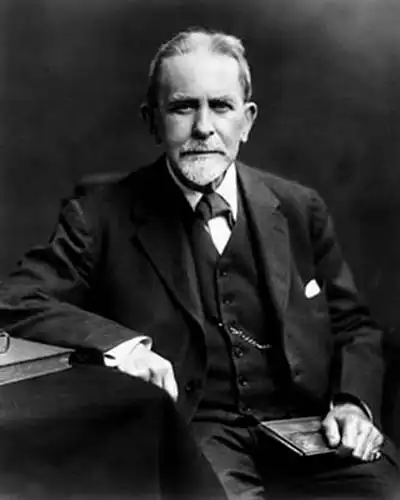
 Archetypes of Mythology
Archetypes of Mythology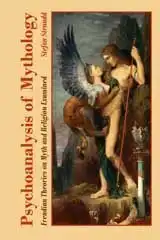 Psychoanalysis of Mythology
Psychoanalysis of Mythology Cosmos of the Ancients
Cosmos of the Ancients Life Energy Encyclopedia
Life Energy Encyclopedia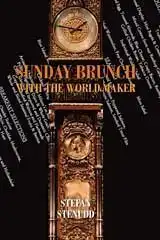 Sunday Brunch with the World Maker
Sunday Brunch with the World Maker Fake Lao Tzu Quotes
Fake Lao Tzu Quotes